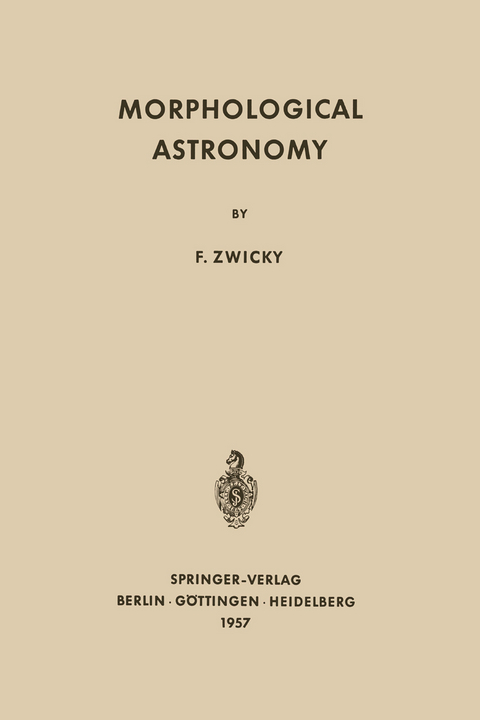
Morphological Astronomy
Springer Berlin (Verlag)
978-3-642-87546-5 (ISBN)
I: Morphological Research and Invention.- 1. Introductory Remarks.- 2. Random Intuition and Systematized Discovery, Research and Invention. Communicable Truth and Incommunicable Truth.- 3. The Formalism of Communicable Truth.- 4. The Method of Negation and Subsequent Construction.- 5. The Morphological Method of Analysis and Construction.- 6. Past Applications of the Morphological Method.- 7. Deficiencies which Aid the Morphological Method.- 8. The Record of the 18-inch Schmidt Telescope on Palomar Mountain.- 9. Specific Plans for a Morphological Approach to Astronomy.- II: Clouds and Clusters of Galaxies.- 10. The Known and the Unknown.- 11. The Large Scale Distribution of Matter in the Universe.- 12. The Coma Cluster of Galaxies.- 13. Excursion into the Theory of Probabilities.- 14. Continuation of the Discussion on the Coma Cluster.- 15. The Cancer Cluster of Galaxies.- 16. The Pegasus Cluster of Galaxies.- 17. Review of the Observations on the Clusters of Galaxies in Coma, Cancer and Pegasus.- 18. Irregular Clusters of Galaxies.- 19. Isopleths of Nebular Distribution.- III: The Large Scale Distribution of Galaxies and of Clusters of Galaxies.- 20. Past and Present Views.- 21. Cluster Cells.- 22. The Field of the Coma Cluster.- 23. The Field of the Pegasus Cluster.- 24. The Field of the Corona Borealis Cluster.- 25. Various Statistical Methods in the Field of Dimensionless Morphology. Contagion.- 26. Comparison of the Observed and of the Random Distribution Curves of Galaxies.- 27. Intergalactic Obscuration.- 28. Counts of Galaxies in Depth and in Width.- 29. Counts of Galaxies in Dependence upon Apparent Magnitude.- IV: Kinematic and Dynamic Characteristics of the Large Scale Aggregates of Matter.- 30. The Velocities of Galaxies.- 31. Some Basic Problems Relating tothe Universal Redshift.- 32. Elements of a Theory of the Large Scale Distribution of Matter in the Universe.- 33. Dimensional Aspects of Large Scale Clustering.- 34. Hydrodynamical Concepts.- 35. Applications of the Virial Theorem to Clusters of Galaxies.- 36. Clusters of Galaxies and the Emden Gravitational Isothermal Gas Sphere.- 37. A Possible Universal Characteristic Central Density of Clusters of Galaxies.- 38. Relative Physical Characteristics of Galaxies and of Clusters of Galaxies.- V: Dimensional and Dimensionless Morphology in Cosmology.- 39. Appraisal of Past Approaches to the Exploration of Extragalactic Space.- 40. Methodology of Cosmological Research.- 41. Distribution of Clusters of Galaxies and their Apparent Populations. Intergalactic Obscuration.- 42. The Frequency of Clusters of Galaxies as a Function of their Angular Diameters. Crucial Tests for the Theory of the Expanding Universe.- 43. The Total Space Occupied by the Large Clusters of Galaxies.- 44. The Luminosity Function of Cluster Galaxies.- 45. Preliminary Test of the Theory of a Flat Expanding Universe.- 46. The Morphological Approach Toward the Determination of Absolute Dimensions and of Absolute Physical Characteristics of Very Remote Objects.- 47. Remarks on the Morphology of Possible Cosmological Theories.- 48. The Einstein Redshift.- 49. The Gravitational Drag of Light.- VI: Morphological Features of Individual Galaxies.- 50. References to the History of the Subject.- 51. Program for the Investigation of Individual Galaxies by the Methods of Dimensionless Morphology.- 52. The Kinematic and Dynamic Characteristics of Galaxies.- 53. The Masses of Galaxies.- 54. Galaxies as Gravitational Lenses.- 55. The Luminosity Function of Galaxies.- 56. Multiple Galaxies and Intergalactic Matter.- VII:Morphological Astronomical Kaleidoscope.- 57. General Remarks.- 58. Observations Made and Planned.- 59. Experimentation with Celestial Objects.- 60. Astrophysical Theories.- 61. Material Reconstruction of Parts of the Universe.- 62. Sociological Problems.- VIII: The Morphological Method and a priori Knowledge. The Magic Numbers.- 63. Philosophy and Communicable Truth.- 64. The Irreducible Foundations of Communicable Truth.- 65. Some Specific Problems.- 66. Outstanding Transcendental Numbers.- 67. The Dimensionalities used in Physics.- 68. Why is Space Three-Dimensional?.- 69. Other Magic Numbers.- 70. The Nature of the Physical Laws.- Epilogue.- Namelndex.
| Erscheint lt. Verlag | 1.6.2012 |
|---|---|
| Zusatzinfo | IV, 299 p. |
| Verlagsort | Berlin |
| Sprache | englisch |
| Maße | 152 x 229 mm |
| Gewicht | 442 g |
| Themenwelt | Naturwissenschaften ► Physik / Astronomie ► Allgemeines / Lexika |
| Naturwissenschaften ► Physik / Astronomie ► Astronomie / Astrophysik | |
| Schlagworte | Astronomy • Cosmology • density • Gravitation • gravitational lens • growth • Morphology • Phase • Philosophy • Physics • telescope • Universe |
| ISBN-10 | 3-642-87546-7 / 3642875467 |
| ISBN-13 | 978-3-642-87546-5 / 9783642875465 |
| Zustand | Neuware |
| Haben Sie eine Frage zum Produkt? |
aus dem Bereich


